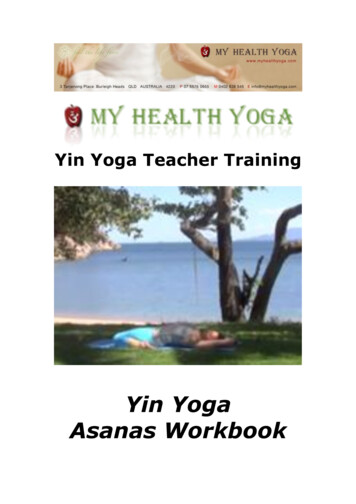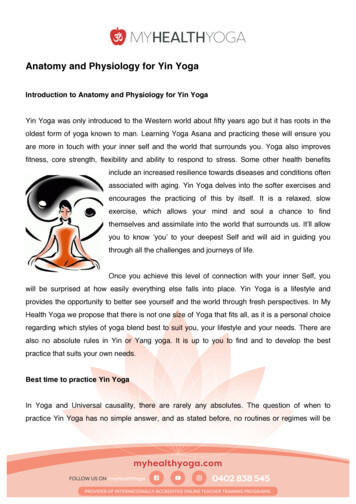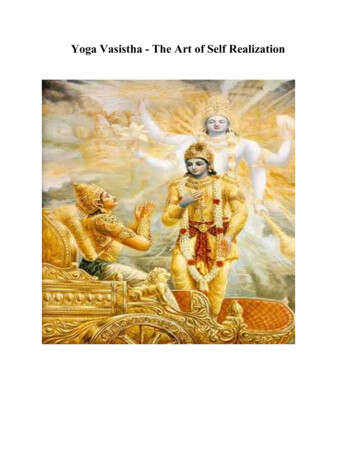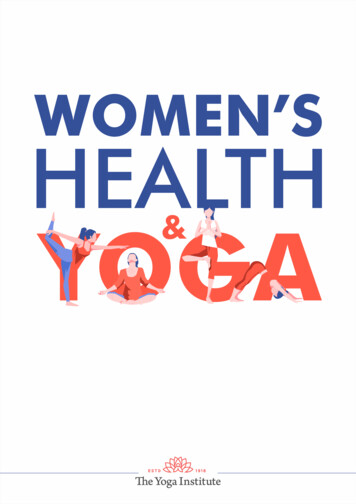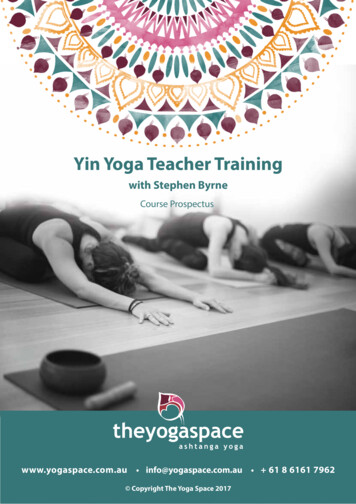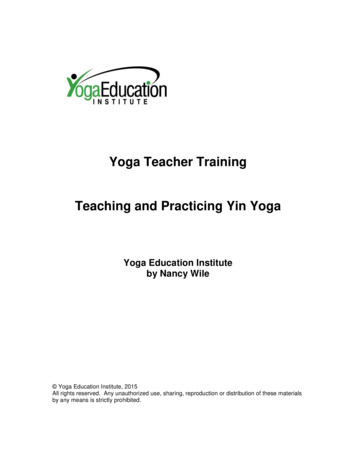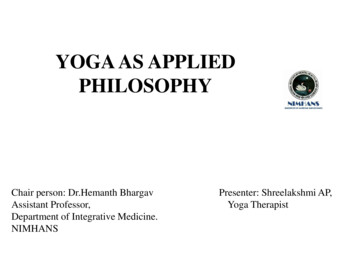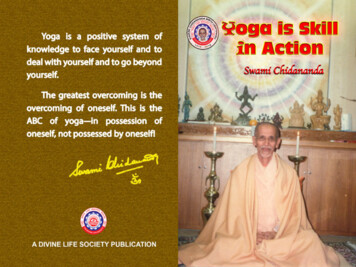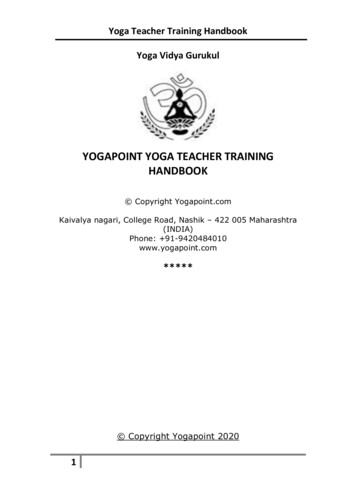
Transcription
Yoga Teacher Training HandbookYoga Vidya GurukulYOGAPOINT YOGA TEACHER TRAININGHANDBOOK Copyright Yogapoint.comKaivalya nagari, College Road, Nashik – 422 005 Maharashtra(INDIA)Phone: 91-9420484010www.yogapoint.com***** Copyright Yogapoint 20201
Yoga Teacher Training HandbookContents IntroductionYoga-The ScienceHistory of YogaTraditional Yoga56914Hatha Yoga Hatha Yoga Summary Hatha Yoga –Glory of the Natha Tradition Hatha Yoga Pradipika (From Ancient text)152026Asana or Yoga poses Asanas Purpose of Asana Practice Pranayama or Breathing techniquesPranayama from Hatha Yoga PradipikaPranayama-The Science of BreathingDeep Breathing & Fast BreathingNadi Shodhan or Alternate nostril breathingBhramari or humming Bee BreathSheetali & Sitkari or Cooling BreathSurya Bhedan or Right Nostril breathUjjayi or Victorious breathBhastrika or Bellows BreathShat Karma (Cleansing Techniques)Kapalbhati (Frontal Lobe Cleansing)Neti (Nasal Cleansing)Vaman DhoutiShankha Prakshalana - Master CleansingTrataka (Eyes Cleansing)Cleansing Techniques and Mind2832343839424546485051535557596163Ashtanga Yoga Yama –Social Discipline Niyama – Self Discipline Asana-Yogic Concept-12656973
Yoga Teacher Training Handbook Pranayama Sadhana Pratyahara, Dharana, Dhyan, Samadhi Patanjali’s Yoga Sutra 3778085Other Types of YogaTypes of YogaKarma YogaJnana YogaBhakti YogaKundalini Yoga88959799100Anatomy & PhysiologyInjuries & PreventionHuman Anatomy & PhysiologyMuscular systemSkeletal SystemJointsDigestive SystemRespiratory SystemCirculatory SystemExcretory SystemReproductive SystemNervous SystemEndocrine SystemPhysiology of Yoga PosesPhysiology of Meditation AsanasPhysiology of Cleansing 65168Yoga Teacher TrainingYoga Teacher Training – Role of yoga teacherThe Yoga Teacher (Blessings fromSwami Satyananda)Aspects of Teaching Asana (Teaching, Revision,Correction)Alignment170173174184
Yoga Teacher Training Handbook 4Alignment – Myth & RealityMicro lessonsCheck lists for micro lessonsFinal LessonImportant Points during lessonGeneral Guidelines for TeachingTips for Effective TeachingLesson PlanningHow To Design Pranayama PracticeEthical Guidelines for TeachersSelf StudyTips for Effective Self PracticeSanskritApplied YogaOmkarYoga NidraYoga for PregnancyObesity & YogaYoga during MenstruationYoga Program - Beginners 8 weeksYoga Program – Classical Foundation 8 weeksYoga Program – Intermediate 22 weeksYoga Program – BackacheYoga Program – weight 47253257265269274287289
Yoga Teacher Training HandbookIntroduction“The body is used to access the mind. Prana is used toaccess awareness and consciousness. Yoga is used to access innerspiritual harmony and balance.”Swami Satyananda SaraswatiYoga’s main aim is to reach the highest planes butyogic practices give direct and tangible benefits toeverybody regardless of their spiritual aims. Yoga alwayshas something to offer people no matter what their age,health or disposition. Whether they want to increase theirflexibility, maintain a healthy weight, reduce stress,receive peace of mind, treat health conditions, maintainhealth and wellbeing or so many other reasons, yoga isthere. Beyond the individual needs yoga is also useful forthe society. Yoga provides a means for people to findtheir own way of connecting with their true selves.Through this connection it is possible for people tomanifest harmony in the current age and for compassionto emerge in places where it is lacking, benefitingindividuals and the whole world.Many different types of Yoga have been practicedfor thousands of years; some important ones areAshtanga Yoga, Hatha Yoga, Karma Yoga, Jnana Yogaand Bhakti Yoga. The Hatha Yoga and Ashtanga Yogastart with preparing the body for experiencing higherdimensions with the practices of Asanas and Pranayama.******5
Yoga Teacher Training HandbookYOGA - THE SCIENCEScience is subject with definite principles,The principles are universal,There are definite results,The results can be experienced by all irrespective of religion, castcreed, gender, culture etc.YOGA fulfills these conditions, hence Yoga is ScienceYoga is a Sanskrit word.Sanskrit is the ancient language of India.All the Indian Philosophy was written in Sanskrit.All Yogic Texts were written in Sanskrit.The basic text is of PatanjaliIt was written about 2500 years ago.Yoga – The History10,000 years ago – Vedas & Upanishadas7,000 years ago – Ramayana5,000 years ago – Bhagavd Geeta2,500 years ago – Patanjala Yoga Sutra1,000 years ago – Hatha YogaYOGA – The meaningYoga means to JOIN. Joining means making one out of two.When the atman joined with paramatman , there will be onlyone.This oneness in Yoga is called KAIVALYA.KAIVALYA is the target of YOGAUniverse & Multi universeDiameter of EARTH – 12,700 kmDiameter of SUN – 14,00,000 kmDiameter of Galaxy – 100,000 Light Years (LY 300,000 km x 60 x60 x 24 x 365) 300,000 x 31,536,000 kmMulti Universe6
Yoga Teacher Training HandbookThere are 100 billion Galaxies in the universe which is observablewith the diameter of 91,280,000,000 LY kms.Unobservable universe is beyond that.There are many universes which are not known.The question arises! Who is the Owner / Organizer/ Controller?That is called “Paramatman”PARAMATMAN (Universal Consciousness) -The controller of theuniverse. In energy form.ATMAN (Individual consciousness) -The controller of the self. Inenergy form.Atman merging with Paramatman is Kaivalya.If Paramatman is the ocean, Atman is a drop of its water, keptseparate in a container (Body)Aim of Yoga* Atman is confined to the body-mind complex and has its ownseparate identity* When Atman loses its own identity, it merges withParamatman.* “Atman becoming Paramatman” is the aim of Yoga!Definition of Yoga. “YOGAHA CHITTA VRITTI NIRODHAHA” (P. Y. S. I – 2) Chitta means mind Vtitti means modifications of mind Nirodhaha means to control Every Yoga Practice results towards this aimYoga is to join* Person to person (Universal brotherhood)* Body & Mind (Concentration)* Mind & Soul (Self Realization)* Soul & Supreme Soul (Samadhi)* Atman & Paramatman (Kaivalya)7
Yoga Teacher Training HandbookYoga is the process of Total Personality development.Yoga Provides: Physical Health Mental Control Emotional Balance Intellectual DevelopmentTools for DevelopmentTools Available - Body (Perfectly Healthy) -- Mind (TotallyPurified) Intellect (Properly Trained)Present Condition - These tools are not proper i.e. the Body isnot Healthy, the mind is not Pure and the intellect is notproperly trained. Yogic Practices help to correct these tools.Yogic practice can be used for: Correcting the disorders of thebody, keeping the body in healthy condition, Improving mentalcapacities, Developing the intellectDifferent Types of YOGAAshtanga (Patanjali) Yoga, Hatha Yoga, Bhakti Yoga, Karma Yoga,Jnana Yoga, Mantra Yoga, Kriya Yoga, Kundalini YogaPatanjali YOGA: Patanjali has specified many paths.We are going to study one path.ASHTANG YOGA – because .It is very systematic, easily accessible to common person.It is explained in detail by Patanjali.Any Yoga practitioner can experience the results.Patanjali’s Ashtanga Yoga - (Eight Limb Yoga)Yama : Guidelines for Social discipline, Niyama : Guidelines forSelf discipline, Asana : Posture, Pranayama : breath Control,Pratyahara : Withdrawal of sense organs, Dharana :Concentration of mind, Dhyana : Meditation, Samadhi: Unionwith Paramatman8
Yoga Teacher Training HandbookHistory of YogaPre-Classical Yoga10,000 BC - 500 BC Due to the oral transmission of sacred texts and thesecretive nature of the teachings the exact dates of theorigins of yoga are difficult to verify.VedasThe first written copies of the vedas were found around5000 years ago but it is believed they were there orallyfor much longer – up to 10 000yrs or even more The Vedas were a collection of sacred songs, mantrasand rituals to be used by Vedic priests known asBrahmans. In the Vedas appear the first mention ofascetics and ascetic practices. In the later writings of theVedas, known as the Upanishads, the first explicitreferences to yoga appear. Concepts of withdrawing thesenses, controlling the mind, and attaining liberation arementioned. 4 - Rigveda, Samaveda, Yajurveda, Atharvaveda 9Archaeological RemainsThe earliest verifiable traces of yoga date back over5,000 years ago to the Aryan civilization in the IndusValley. Archaeological excavations from the regionuncovered numerous seals depicting a human figuresitting in a meditative position.Mohenjo-daro & Harappa
Yoga Teacher Training HandbookRamayana About 7000 yrs old The Ramayana consists of 24,000 verses and tells thestory of King Rama of Ayodhya kingdom whose wife Sitais abducted by Ravana, the demon king of Lanka. Explores human values and the concept of dharma.Mahabaharata About 5000yrs ago Written by the Sage Vyasa Longest known epic poem which consists of over 200,000 individual verse lines10
Yoga Teacher Training Handbook 11Includes the Bhagavad Gita, story of Damayanti, anabbreviated version of the Ramayana, and theRishyasringa.Contains philosophical and devotional materialExplains the four "goals of life" or purusharthas.Bhagavad GitaVery important text on yoga, known as “Indianpsychology”Contains solutions to the problems of human life.Bhagavad Gita has inspired generations, and greatcivilizations who followed the teachings of BhagavadGita.Many wise people, seers, yoga masters regarded Gita asthe most precious knowledge.Bhagavad Gita is a dialogue between Lord Krishna whosymbolises supreme consciousness and Prince Arjunawho represents human consciousness. Prince Arjunaasks questions to Lord Krishna about his problems.Arjuna is in a state of depression, and despondency.Lord Krishna helps him realise the purpose of life,meaning of life and inspires Prince Arjuna to live his lifein contentment and peace.Krishna explains the concepts of dharma, karma yoga,bhakti yoga and jnana yoga.Classical Yoga - Patanjali500BC approximatelySame time as Buddha, incl yamas and niyamas whichcomplemented Buddhas teachingsYogena chittasya paden vacham malum sharirasyachavaidyakena. Yopa karottam pravaram muninampatanjalim pranjali ranatosmi. (Patanjali purified thelanguage through Sanskrit, he purified the body throughAyurveda, he purified the mind through yoga.)
Yoga Teacher Training Handbook Yoga Sutras were written to explain the process andsystematic analysis of practical methods for awakeningand expanding the higher faculties of mind, intellect,quality of consciousness.Concisely packed into 196 lines or Sutras so thatstudents can easily remember these sutras. Divided into4 chapters. Very concise meanings.Post-Classical Yoga (Hatha & Tantra)600 AD - 1500 AD 12Hatha Yoga – focus on purification, away from mindfocus but to prepare for working on the mind once thebody was purified. Focus on asana, cleansing, pranayam,mudras, bandhas.Too many people focusing on meditation and tantricrituals.Hatha yoga came about from 600 AD but referenceswere found previously in the Upanishadas, Puranas andin South America.Sage Matsyendranath and his disciple Sage Gorakhnath,founded the Nath tradition.Shiva Samhita 13th C ADGoraksha Samhita – 11th C ADHatha Yoga Pradipika – Swami Swatmaram 12th C AD –Gheranda Samhita – Sage GherandaHatharatnavali – Srinivasabhatta MahayogindraSiddha siddhanta paddhati – 9th or 10th Century ADModern Times 1890's - PresentIn the late 19th century, yoga masters began traveling tothe west. The first of these was Swami Vivekanandawho wowed the audience at a lecture on yoga in Chicagoin 1897. He was a disciple of Ramakrishna
Yoga Teacher Training Handbook Paramahamsa Yogananda – Wrote Autobiography of aYogi, Lectured in United States from 1920, taught a formof Kriya yoga, started Self Realisation Fellowship, In the 1920's and 30's Hatha Yoga was stronglypromoted in India with the work of T. Krishnamacharyaand Swami Sivananda. In 1923 Krisnamacharya openedthe first Hatha Yoga School in Mysore, South India.Among his students were BKS Iyengar, Patthabi Jois Swami Sivananda SaraswatiIn 1936 he founded the Divine Life Society in Rishikeshon the banks of the Ganges River. Mahasamadhi 1963.Swami Sivananda’s DisciplesSwami Chidananda & Swami Krishnananda – Divine LifeSociety, Swami Satyananda – Bihar School, SwamiSatchidananda – Integral Yoga, Swami Vishnudevananda– Sivananda Yoga Vedanta Centres, SwamiChinmayananda – Chinmay Mission Swami Satyananda Saraswati – founded Bihar School ofYoga, International Yoga Fellowship Movement, TheYoga Research Foundation, The Satyananda Yoga Tradition continues to disseminatethe yogic tradition throughout the world, carry outscientific research and publish numerous books on yogaand yoga related topics. Swami Kuvalayananda – 1924 Founded Kaivalyadhama,in lonavala, near Mumbai the first scientific researchinstitute in yoga.13
Yoga Teacher Training HandbookTraditional YogaYoga as Lifestyle – Traditional YogaAuthority text on Yoga ‘Bhagavad Gita’ – Controlled Thoughts, Emotions and Actions Controlled / disciplined diet, Controlled / disciplined sensory organs, Controlled behaviour, / daily routine Controlled sleep, & relaxation Controlled karmas, is the yoga lifestyle to remove negativity in life.2 Important qualities for Yoga Practice1. Abhyas – Continued study, repetitive, regular practice orstudy2. Vairagya – non attachment or not thinking about whathappened yesterday and continue with the same resolve14
Yoga Teacher Training HandbookHatha Yoga A Science of Body purification and awakening of Pranicenergy. Origin of Hatha Yoga Origin in Tantras (more than 10000 years old) Development of Hatha yoga is in 6th century AD to 15thCentury AD Founded by Great Sage Matssyendranath and hisdisciple Gorakshanath. Reference books Hatha Yoga Pradipika – Swami Swatmaram Gheranda Samhita – Sage Gheranda Goraksha Satakam – Guru Gorakshanath Shiva Samhita Yoga Taravali – Sage Adi ShankaracharyaConcept of Pancha Kosh – Five levels of existence Annamaya – physical body, Pranamaya – Energy body, Manomaya- Mind body, Vijnanamaya – Knowledge body, Anandamaya – Bliss bodyHatha - Science of Body – Mind Balance Pranamaya Kosha - Prana energy – vital energy, lifeforce, energises body & mind Nadi is Pranic Energy channel or passage 3 important nadis out of 72000 – Sushumna, Pingala &Ida Ha – Pingala nadi or sun principle, Tha – Ida nadi ormoon principle Hatha is balance of Pingala and Ida &body – mind Pingala - Right nostril, Sun / Male principle, PhysicalEnergy, Represents Body15
Yoga Teacher Training Handbook Ida - Left nostril, Moon / female, Mental Energy,represents MindBalance of Body & Mind Imbalance of physical and mental energies is state ofdisease. Imbalance is due to blockages in the ‘nadis’ or energypassages. Aim of Hatha Yoga - Purification of this ‘nadis’ or energypassages.Steps or Contents of Hatha Yoga Shatkarmas – 6 cleansing techniques Asanas – body postures Pranayama – control of prana / breath Mudras – psychic gestures (inducing mental attitudes) Bandhas – Energy locks Meditation Shatkarma –Cleansing techniquesTo remove accumulated toxins in the body.Homeostasis – Balance of entire body and mind,especially the Nervous system and endocrine system.Removing blockages to Nadis.Awakening the psychic faculties.6 Shatkarmas Neti – nasal cleansing Dhouti – internal cleansing Basti – yogic enema Nouli – abdominal massage Kapalbhati – frontal brain cleansing or cleansing of lungs Trataka – cleansing of eyes16
Yoga Teacher Training HandbookAsanas – Yoga poses Steady and comfortable postures Aim of Asanas is to achieve healthy body bystrengthening various systems and achieve peaceful andstable mind Asanas increase body awareness and connect mind tobody Asanas promote relaxed and deep breathing Asana technique 70% of the ideal posture Become aware of body posture & stressed parts(including muscles and joints) Become aware of breath Try and relax the stressed parts and develop steady andcomfortable posture Asanas Various forward bends, back bends, side bends, twists,inversions, balancing asanas, stretches, and relaxationasanas strengthen all most all the voluntary andinvoluntary muscles. But purpose of Asana is to prepare for meditation somost important are 2 asanas, Padmasana (Lotus pose) &Siddhasana (Perfect or balance pose) Mastery of Asana – maintaining for 3 hours in steady andcomfortable way.Pranayama Pranayama Prana ayama – control & extension ofprana (vital force) Blockages in nadis dissipate energy, aim of pranayama isto clear these blockages and purify nadis. Breath and nervous system Breath and mind connection17
Yoga Teacher Training Handbook Use of efficient breathing method (@ 60% abdominal @ 35% chest @ 5% clavicular breathingLess breaths per minute is long lifeBreathing proportions – discipline the breathTypes of Pranayama Preparation - Nadi Shodhan or Anuloma Viloma orAlternate nostril breathing (purifying Pingala & Ida) Surya Bhedan – right nostril breath Ujjayi – Victorious breath / psychic breath Sitkari – Cooling breath Shitali – Cooling breath Bhramari – Humming bee breath Bhastrika – Bellows breath Murchha – Swooning or fainting breath Plavini – Gulping breathMudras & Bandhas Mudras – Psychic gestures which induce a particularstate of mind. Bandhas – Pranic Energy locks Mudras & Bandhas control the pranic energy, which isawakened with pranayama practice. 10 Mudras & 3 Bandhas in Hatha Yoga Jalandar Bandha – chin lock Moola Bandha – root lock Uddiyan Bandha – Abdominal lock18
Yoga Teacher Training HandbookNotes-19
Yoga Teacher Training HandbookHATHA YOGA – GLORY OF THE NATH TRADITIONBY- GANDHAR MANDLIK (RISHI DHARMACHANDRA)There are many texts on Hatha Yoga where we can findmany references to its glorious tradition and the lineage of Guruswho taught this wonderful and complete set of techniques for theevolution of its followers. Some of these texts include the HathaYoga Pradipika by Swami Swatmaram, Goraksha Shatakam,Goraksha Samhita, Siddha Siddhanta Paddhati by Gorakhnath,Gherand Samhita by sage Gheranda, Yoga Taravali by AdiShankaracharya, Hatha Ratnavali and Shiva Samhita.This tradition was founded by Sage Matsyendranath andhis disciple Sage Gorakhnath. Matsyendranath founded the"Nath" sect and laid the spiritual guidelines for its followers. Theydesigned wonderful techniques from the Tantras, leaving asidesome of the ritualistic parts which had many sociallyunacceptable methods. They systematically put these techniquestogether to make a very logical but safe approach to achievinghigher states of consciousness and attaining perfections.Science of Hatha Yoga developed during 6th and 15thcentury A.D. The practices mentioned seem to have influence ofthe Tantras, and other tantric traditions like the Shakta tradition,Buddhist Bajrayanis, Kapaliks and Kauls. But Sage Gorakhnathemphasized the values of celibacy, ethics and morality, characterand noble deeds in life which had less importance in manyTantric traditions. Hatha yoga gained popularity over a period oftime and many sects merged in to this tradition and even theoriginators started calling Gorakhnath their Guru.Before the rise of Hatha Yoga, there was a lot ofinfluence of Buddha's teachings on many sections of the societyin the Indian subcontinent. They were trying to follow the ethicsand morality as preached by Buddha and Mahavir (the founder ofthe Jain religion).The systems of meditation were also in practice.But a disadvantage of these systems was that the preparatorypractices were ignored and ethics were overemphasized. TheHatha Yoga system addressed this issue in a logical way,creating room for body purification and mental stability before20
Yoga Teacher Training Handbookstarting with meditation and other higher practices. To learn andpractice meditation, one needs to have physical health andstability. The mind can only be focused to experience higherstates if the body is healthy and is in harmony with the mind.These became the theme of Hatha Yoga and the cause of itspopularity.Many Asanas (body postures), Pranayama (breathingcontrol and retention), Shatkarmas (cleansing techniques), Mudraand Bandhas (psychic gestures and energy locks) are mentionedin the Hatha Yoga tradition. Their effects on the body and mindare magical. The techniques create balance between the body,mind and energies. The practice helps maintain a youthful body,gives extra sensory powers and awakens higher states ofconsciousness but the main purpose of Hatha Yoga is to achievethe same higher states of samadhi, nirvana or self realization.Hatha Yoga Gurus have always highlighted this purpose. All theHatha Yoga texts also emphasise on this achievements as theobjective of practices.Ashtanga yoga starts with ethics & morality (Yama issocial discipline - non-violence, truth, celibacy, non- stealing, nonpossessiveness and Niyama is self discipline - purity,contentment, austerity, self study, faith). Patanjali, the founder ofAshtanga Yoga, was contemporary to Buddha and his teachingsshow the influence of Buddhist philosophy. That may be one ofthe reasons why ashtanga yoga starts with ethics and morality.Interestingly Hatha Yoga does not start with Yama andNiyama. If you look at the ethics and morality they are nothing buthigher values in life. These values should come from within astransformations but if you try to force yourself to follow these thenit creates more inner conflict than helping you on the higher path.Those who try to follow them religiously and forcefully may findthemselves in trouble creating imbalance in their personality andlosing peace of mind. Many religions have preached these samevalues but how many people follow these guidelines? So if youwant to follow these self discipline and self control you mustprepare yourself.21
Yoga Teacher Training HandbookThe Hatha Yoga approach is simple and logical - youmust purify your body first. There are three types of wasteproducts in the body, mucus (kafa), gas (vata) and acidity (pitta).Ayurveda says if these three types are balanced then perfecthealth can be maintained. So Hatha Yoga recommends sixcleansing techniques to balance these 3 secretions in the body.Neti (nasal cleansing), Dhauti (Internal cleansing), Basti (Yogicenema), Nouli (Abdominal massage), Kapalbhati (Frontal braincleansing) and Trataka (cleansing of eyes) are the six typesrecommended. When these 3 secretions (energies) are balanced,all the systems of the body like the respiratory, digestive,excretory, nervous and other systems work in perfect balance. Asper Hatha Yoga the cleansing techniques remove the blockagesin the nadis which create obstruction to the flow of prana (vitalforce) and results in various physical and mental problems. Socleansing gives perfect health and vitality.After the cleansing techniques, asanas are the first stepin Hatha Yoga. The purified body is then subjected to thediscipline of asanas. Asana is a steady and comfortable posturewhich is essential for meditation and higher practices. Thesanskrit word asana comes from the verb "asa" which means "tobe established in". So a body posture which is maintained for along time can only be termed as "Asana". The longer practice ofpostures balances prana (vital force) in the nadis.In asanas you subject your body to different stretchesand strains. Then you try to maintain the posture in a relaxedmanner. This practice builds the strength and stamina. Especiallymuscular system is strengthened, which is the support for allother systems. Functioning & efficiency of the internal organs isimproved. This affects all other parts of the body in positivemanner.In asanas, you try and connect the mind to the body. Youtry increasing the awareness of body parts, focusing on stressedjoints and muscles, maintaining awareness of the breathing. Oneneeds a lot of skill in trying to relax the muscles and differentparts under stress during asana practice. This is strengthening ofBody- Mind relationship.22
Yoga Teacher Training HandbookA healthy and peaceful body is the starting point foradvance practices. This is the purpose of Asanas.The next step is pranayama, which literally means controlof prana (vital force). Prana is the vital force or energy in theuniverse, all the actions is a result of movement of prana. Thissame energy also moves through the body and mind. If one cancontrol the prana then all the functions of the body and mind canbe controlled. So the purpose of pranayama is to control thisenergy to control the body & mind. With the practices ofpranayama all the chakras (psychic energy centres) are purifiedand awakened. The sushumna nadi is awakened which is thepathway for kundalini energy(Kundalini is dormant potential forcein every living being).Mudras & Bandhas in Hatha YogaMudra means a gesture showing a particular state ofconsciousness, emotion or attitude. Bandhas are energy locksused to control the flow of prana. Mudras and Bandhas are veryimportant discoveries by Yogis and Rishis. They used them tosuccessfully alter the state of mind, thought process, emotionsand control the higher awakenings of Prana. Some of thesemudras allow the mind to become more focused, some are todeepen the awareness and to awaken the dormant energy,dormant potential or kundalini energy. Some of the mudras aredescribed for achieving psychic powers and extrasensoryperceptions.In Hatha Yoga, many mudras are described with apurpose to awaken the dormant kundalini energy and channelizeit to reach the higher states of consciousness. These mudrashave been described as destroyers of old age and death and torealize a state of consciousness beyond the time and spacebarrier. The body is made up of matter (earth) and will change tooriginal earth form one or other day and there is no immortality tothe body but the awareness, consciousness or mind can reachhigher dimensions where there is no death and old age. This ideawhich is related to the concept of time and space barrier is thesubject of interest for the yogis. They described this state as totalfreedom or immortality, the same state was described by Buddha23
Yoga Teacher Training Handbookas Nirvana or Samadhi by Patanjali. In this state there is nobinding of the time barrier which makes past, present and futurefor a normal state of consciousness, and no space barrier whichbinds us to a particular place in the universe. Going beyond thisis described as a blissful and eternal state of existence in all theYogic texts by many great Rishis and Sages. Mudras in HathaYoga are used for this purpose.Mudras and bandhas have a profound effect on the bodyand mind. They affect the body in a positive way by bringingbalance to the nervous system and endocrine system. Theyregulate the stimulation to sympathetic and parasympatheticnervous system, also affecting involuntary functions of thenervous system. When the nervous system is balanced theendocrine system is in harmony and in balance. Different organsare also affected by the practice of mudras and bandhas asdifferent mudras and bandhas concentrate the pranic energy inparticular body parts. These techniques have a positive effect onthe entire body-mind complex. They can be used to treat varioushealth conditions, ailments and diseases.Mudras in Hatha Yoga are recommended after masteryover Asana and Pranayama. A certain level of proficiency isneeded to practice mudras. Basic requirement is healthy body,stronger nervous system, better neuromuscular coordination andan ability to concentrate. This is achieved with Asana andPranayama practices which leads to being able to control the flowof prana and to strengthen the mind which are the keys tosuccess in the study of Mudras and Bandhas.Interestingly Hatha Yoga does not emphasise onmeditation except Nada (subtle eternal sound awareness)meditations. The practices of mudras and Bandhas naturallybring a deep state of meditation without any conscious efforts. Sowe can say that Hatha Yoga is the science of Body purification,strengthening of body –mind relations & pranic awakenings.Prana – Vital Force or life forceMudra – Gesture indicative of particular state of consciousness,attitude or emotion24
Yoga Teacher Training HandbookBandha – Pranic Energy locksAsana – Physical posturePranayama – Control of Prana or vital forceRishis – Seers or Yogis who discovered higher dimensions ofconsciousnessKundalini – Dormant Potential Force assumed to be present inevery living being and associated with higher spiritualawakenings.Hatha – Ha – Sun, Tha- moon Hatha yoga is a disciplineconsisting of practices such as Asanas, Pranayama, Mudra andBandhas to reach the states of balance or harmony or selfrealization.25
Yoga Teacher Training HandbookHATHA YOGA PRADIPIKA(A text on Hatha Yoga by Swami Swatmarama)By Guruji - Rishi DharmajyotiHatha Yoga Pradipika is one of the most authentic textbooks on Hatha Yoga, written in 1200 AD by SwamiSwatmarama, a great Yoga Guru who formulated the principles ofHatha Yoga and systematically explained various techniques, itseffects on body, mind and states of consciousness. This is acomprehensive text on Asanas, Pranayama, Cleansingtechniques, Mudras (Mental attitude or gentures), Bandhas(Energy locks), Nada (Sound) Meditation and many moreguidelines for following the path of Yoga.Swami Swatmarama was the follower of the NathTradition, (followers of Adi Nath or Lord Shiva), taught by greatGurus like Gorakshanath and then Matsyendranath. This is thetradition of sages who live in caves or Himalayas and renouncematerial life adopting sannyasa (sannayasa – renunciation ofmaterial life, sannayasi - a monk).Let us see the meaning of the word Hatha, it is
Yoga Teacher Training Handbook 3 Pranayama Sadhana 77 Pratyahara, Dharana, Dhyan, Samadhi 80 Patanjalis Yoga Sutra 85 Other Types of Yoga Types of Yoga 88 Karma Yoga 95 Jnana Yoga 97 Bhakti

